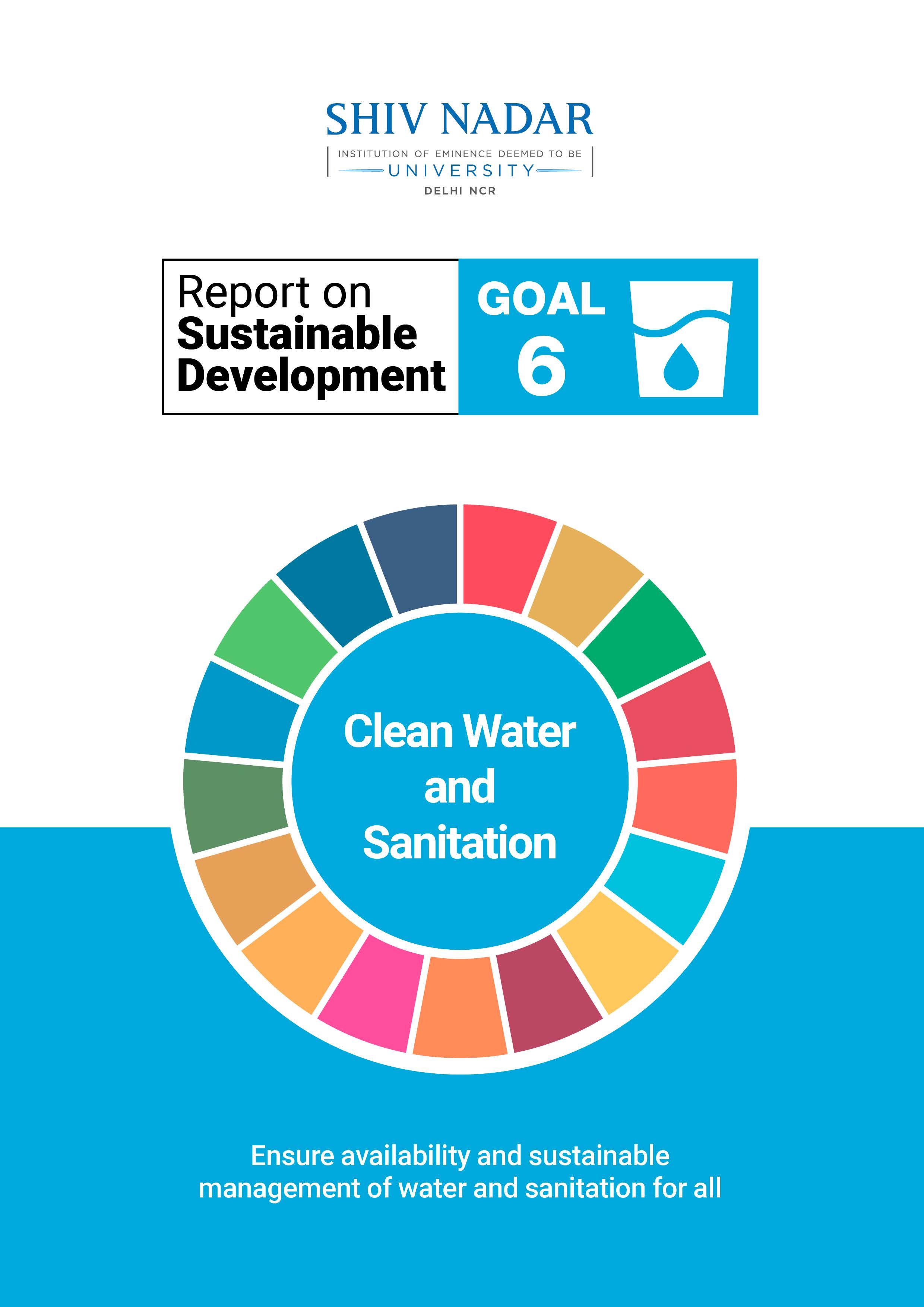

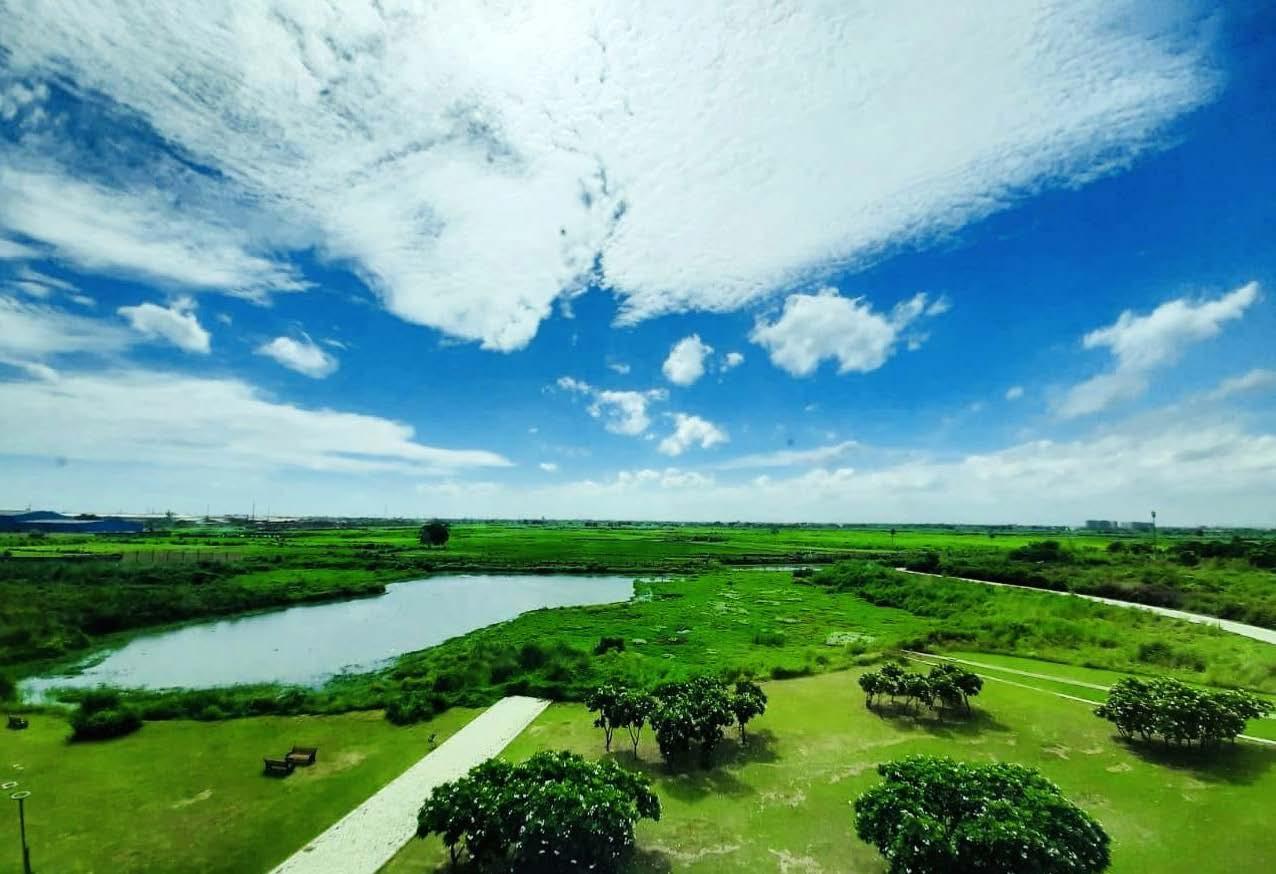
In a recent webinar on the way forward to the UN Water Conference 2026, there was a clear call for action based on unwavering commitment to water connecting all people and communities across the world. In this sense, SDG 6 is the linchpin to achieving 17 other Sustainable Development Goals.
Sustainable Development Goal 6 outlines six targets within which it explicitly addresses what needs to be done to achieve the goal by 2030. At Shiv Nadar University we have embraced a four-pronged strategy for meeting the water challenge through teaching, research, our core institutional practices, and water partnerships.
In 2024, Shiv Nadar University became a member of the United Nations Academic Impact. We were also selected as the Hub Co-Chair for SDG 6 for a threeyear term from January 2025 to December 2027. Among the impressive and globally diverse group of universities selected to fulfill the roles of SDG Hub Chairs for 17 SDG goals, Shiv Nadar University was selected based on its proactive approach to addressing important issues related to water use and availability. The selection also acknowledged our strong commitment to SDG 6, which is demonstrated through extensive projects on water management and its influence on local education about sustainable water practices.
In what follows, we highlight a selection of our work in teaching, research, core institutional practices, and water partnerships
The UN 2024 World Water Development Report, Titled “Water For Prosperity And Peace,” Highlights The Crucial Role Of Water In Achieving Global Prosperity And Peace, Emphasizing Its Importance For Human Needs, Health, Livelihoods, And Sustainable Development.
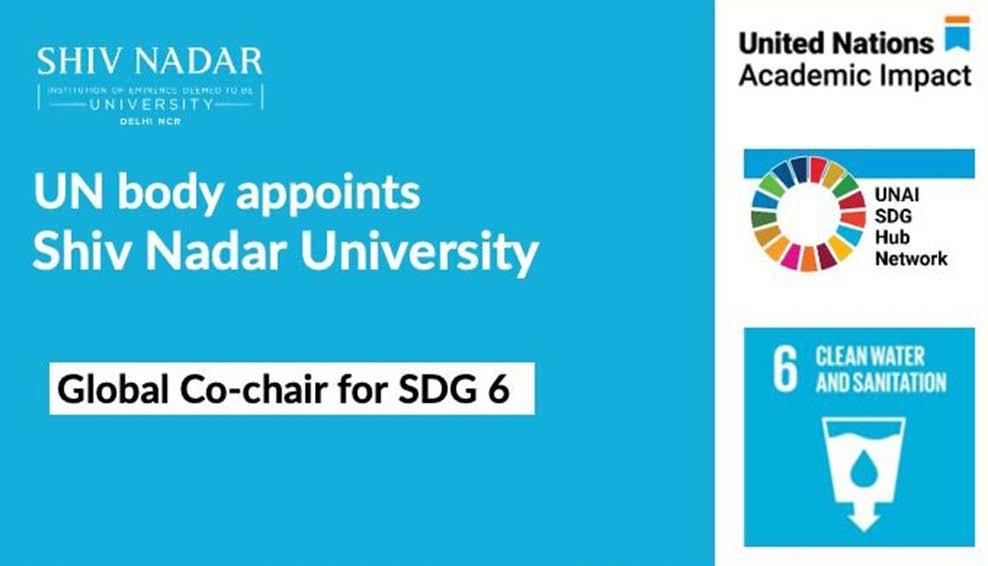
TEACHING AND LEARNING
At Shiv Nadar University, we offer many courses, both at the undergraduate and graduate levels, that incorporate the essential multi-disciplinary character of water. The compulsory courses for undergraduate students include historically and socially contextualized understanding and multidisciplinary perspectives of water. Some examples are Water Resources Engineering (CED 303), The Political Economy of Urban Waste and Water in the South (IRG 107), The Anthropology of Water (SOC 115), Industrial Wastewater Treatment (CED 644), Elements of Water Resources (CCC 640), Freshwater Ecology (CCC 716), Introduction to Water Pollution (CCC 646), Agriculture, Land, and Water Crises and Responses (CCC 718), Water Resources Engineering (CED303), Introduction to Water Resources: Indian Perspective (CCC 655), Water power Engineering (CED 657), Watershed Management (CED 319),
Environmental Hygiene, Sanitation and Waste Management (CCC 714).
STUDENT PROJECT
Our program on Opportunities for Undergraduate Research (OUR) program enables undergraduate students to undertake research projects with faculty members in any discipline.
Our students are doing meaningful research projects under the guidance of Dr. Gopal Das Singhal, Professor, and Dr. Hitesh Upreti, Assistant Professor, Department of Civil Engineering. These projects are using satellite remote sensing for agricultural monitoring and detecting crop water stress, which is crucial for food and water security. The study area of the projects is the farming fields located in the vicinity of our university. The project impacts SDG 6 and 2:
1. Crop monitoring and detection of irrigation events in agricultural fields using remote sensing techniques
Chinthamaneni Sryodh is working on a project that uses satellite remote sensing to estimate the soil water content and detect the irrigation dates in the farmer fields located in the vicinity of the university. Also, remotely sensed data from the optical satellites are used to monitor the harvesting dates of the crops.
2. Assessment of crop water stress index using remote sensing and machine learning techniques
Likith Muni’s project is about optical and thermal data from the satellites that are used to monitor and map crop water stress for wheat crops grown by the farmers in the region. Machine learning models are used to predict the crop water stress values.
3. Estimation of evapotranspiration using machine learning models and field-collected data
Sanjana is working on crop water use (CWU) estimates that are predicted using machine learning models. The aim is to predict the CWU for situations when limited data is available. Monitoring and quantifying CWU is indispensable for assessing crop health and predicting food production.
RESEARCH
Emerging technology used for revolutionizing agriculture and understanding water
Dr. Gopal Das Singhal, Associate Professor, Department of Civil Engineering; Associate Head, School of Engineering, and Dr. Hitesh Upreti, Assistant Professor, Department of Civil Engineering, are using emerging satellite and drone remote sensing techniques, data analysis, and IoT to research water management and agricultural monitoring to attempt to alleviate agricultural deficiency.
The research team uses the European Space Agency’s Sentinel 1 and 2 and NASA’s Landsat satellites to study soil moisture and crop health, along with their Surveybot drone. The high-end drone, with a payload capacity of 10kgs, is equipped with thermal sensor multispectral and hyperspectral cameras. The data collected is analyzed through Pix4D, a photogrammetry and drone mapping software, to provide inputs to monitor parameters like water requirement and crop health.
Wetlands contribution and linkage to support SDGs, its indicators and targets- A critical review
This study marks one of the pioneering efforts to compile comprehensive information on Ramsar sites globally. It delves into the significance of wetlands and the designation of Ramsar sites across various countries, incorporating a concise exploration of the utilization of Unmanned Aerial Vehicles (UAVs) for wetland monitoring and assessment. Additionally, the study conducts a comparative evaluation of Ramsar sites, analyzing their percentage area and overall coverage worldwide. Incorporating a Scientometric analysis utilizing the Scopus database, the study features a co-occurrence map, thematic map, thematic evolution trend, and country collaboration map. Emphasizing the interconnection between wetlands and Sustainable Development Goals (SDGs), particularly SDG6 (Clean Water & Sanitation), SDG12 (Responsible Consumption & Production), SDG13 (Climate-Action), SDG14 (Life Below Water) and SDG15 (Life on Land), the study delves into associated targets and indicators. Targets such as 6.1, 6.2, 6.3, 6.4, 6.5, 6a, 6b of SDG-6, 12.1,

12.2, 12.4 of SDG-12, and 13.2, 13.3 of SDG-13 align with wetland management and conservation. Moreover, it affirms the role of wetlands in supporting targets 14.1, 14.2, 14.3, 14.4, 14.5, 14.6, 14a-c of SDG-14, and 15.1, 15.5, 15.6, 15.7, 15.8, and 15.8 of SDG-15. Policies, regulations, and management plans of different countries relevant to supporting and establishing relationships with SDGs are discussed in detail. The study offers a detailed exploration of these targets, elucidating indicator types associated with each SDG target. By doing so, it provides valuable insights for future researchers and policymakers, underlining the indispensable contribution of wetlands to the direct and indirect fulfillment of SDGs 6,12,13,14,15 and 17. © 2024 ERP Environment and John Wiley & Sons Ltd.
Mohanty, Smrutisikha, Prem Chandra Pandey, Manish Pandey, Prashant K. Srivastava, and Chandra Shekhar Dwivedi. “Wetlands contribution and linkage to support SDGs, its indicators and targets‐A critical review.” Sustainable Development (2024).
Case Study - CHARCOAL BRIQUETTE: TURNING AN INVASIVE WATER HYACINTH INTO AN OPPORTUNITY
Dr. Brikramjit Rishi, Professor of Marketing, has published a case study exploring ‘how communities around Laguna De Bay, Philippines, are transforming the invasive water hyacinth into sustainable charcoal briquettes, creating economic opportunities while helping to preserve the environment.’ One can dive into this innovative solution and discover how a challenge can become a sustainable win-win for both people and nature. The case study reflects on many SDG goals, such as 2, 3, 6, 8, and 13.
Dedicated Labs on Campus to deliver cutting-edge research
Water Management Field Laboratory
To address the critical issues of food & water security nexus, water management, and the impact of climate change on water availability, the Department of Civil Engineering established the Water Management Field Laboratory in April 2021.
The Ministry of Water Resources and the Ministry of Agriculture & Farmers’ Welfare, Government of India, have marked these research themes as areas
of national importance. These areas are also aligned with the focus of the government’s national missions on more crops per drop (increasing water use efficiency), har khet ko pani (increasing the cultivated area under irrigation), and Goal 4 (Improving water use efficiency by 20%) and Goal 5 (promotion of basin level integrated water resources management) of the National Water Mission.
The laboratory is co-funded by the Government of India and the university to serve as a state-ofthe-art research facility. It has an extensive crop experimentation facility equipped with a drip irrigation system and research equipment facility for monitoring crops and soil parameters.
Two broad research areas the lab focuses on are:
• Agriculture Water Management
• River hydraulics.
Currently, doctoral students and undergraduate researchers are conducting their research at this lab.
One of the large projects hosted in the lab is “Optimizing Irrigation and Nutrient Management in Wheat Production by Integrating Advanced Technologies to Save Water and Enhance Agricultural Productivity Under Variable Climate”
Climate change and a growing global population are increasing the demand for efficient irrigation practices, especially in regions where water scarcity threatens agricultural productivity.
To address this challenge, ongoing research at the Water Management Field Laboratory is focusing on optimizing water use in wheat production through controlled field experiments. These experiments, conducted over consecutive years, compare different drip and flood-irrigated treatments based on soil moisture depletion, crop water requirements, and conventional local practices.
The research aims to evaluate grain yield, analyze soil moisture extraction patterns, and identify strategies that minimize water use while maximizing crop yield. A key aspect of the study is quantifying deep percolation in local farmers’ fields, which leads to low water use efficiency. By understanding how water is lost, the research seeks to inform modifications in irrigation practices to reduce these losses. Overall, this research integrates
advanced technologies such as remote sensing, machine learning, and UAV to enhance precision agriculture.
The following research scholars are working on this project with different objectives:
1) Aditi Yadav works on ‘Assessment of crop water stress index and its modelling for efficient irrigation water management.’
2) Ghanshyam Giri is working on ‘Assessment of soil moisture and its variability for irrigation scheduling in cropped area,’ with an objective to analyze grain yield, water productivity, soil moisture extraction patterns, and spatiotemporal variability of soil moisture using remote sensing and statistical methods while also modeling biomass and grain yield.
3) Manoj Yadav is working on ‘Monitoring crop water use and crop water stress using remote sensing in an agricultural area,’ with an objective to monitor crop water use and health, analyze spatio-temporal variations in crop water use and crop coefficient (Kc), and assess crop water stress using thermal remote sensing and meteorological data.
4) Apoorva Yadav works on ‘Evaluation of crop response to water and nutrient stress using remote sensing techniques.’ The objective is to estimate and map soil nutrient variability using UAV multispectral and hyperspectral data and to monitor crop yield by analyzing the combined effects of water and nutrient stress.
5) Adwait is working on ‘Synergetic use of machine learning and hyperspectral remote sensing for agricultural water management’. The objective is to monitor crop health at different stages using vegetation indices from remote sensing, compare indices from spectroradiometer and UAV, and predict yield using machine learning algorithms.



Geoinformatics Laboratory
The Geoinformatics Laboratory hosted in the Department of Civil Engineering includes advanced remote sensing equipment, a processing facility, and an equipment facility used for surveying. The field lab facilities of the Water Management Field Laboratory are also utilized to collect spatial and drone remote sensing data from the agricultural field plots. The advanced remote sensing facility includes sensors and equipment such as a drone (hexacopter), multispectral (RedEdgeP-Red, & RedEdgeP-Blue) camera system, spectroradiometer, RGB camera, plant canopy analyzer, hyperspectral camera system, L-Band radiometer, infrared thermometer (IRT), Flir Vue Pro R thermal sensor, and Differential Global Positioning System (DGPS).
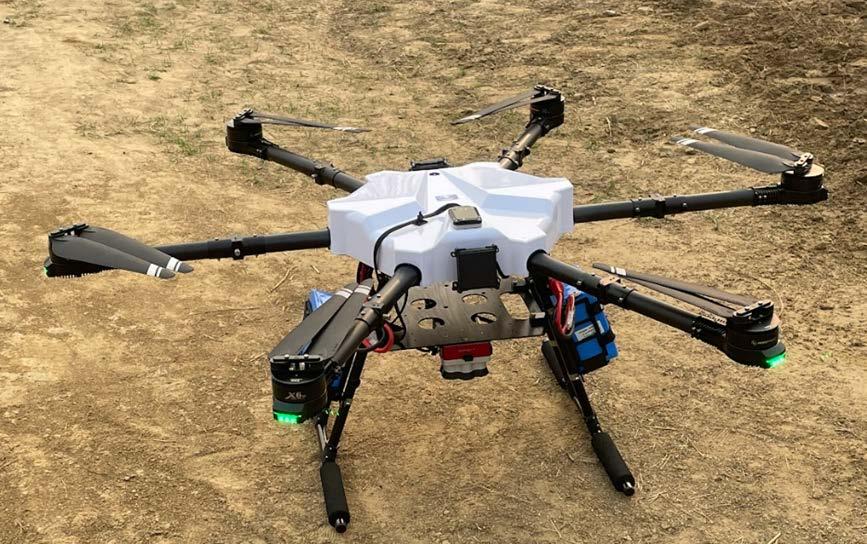
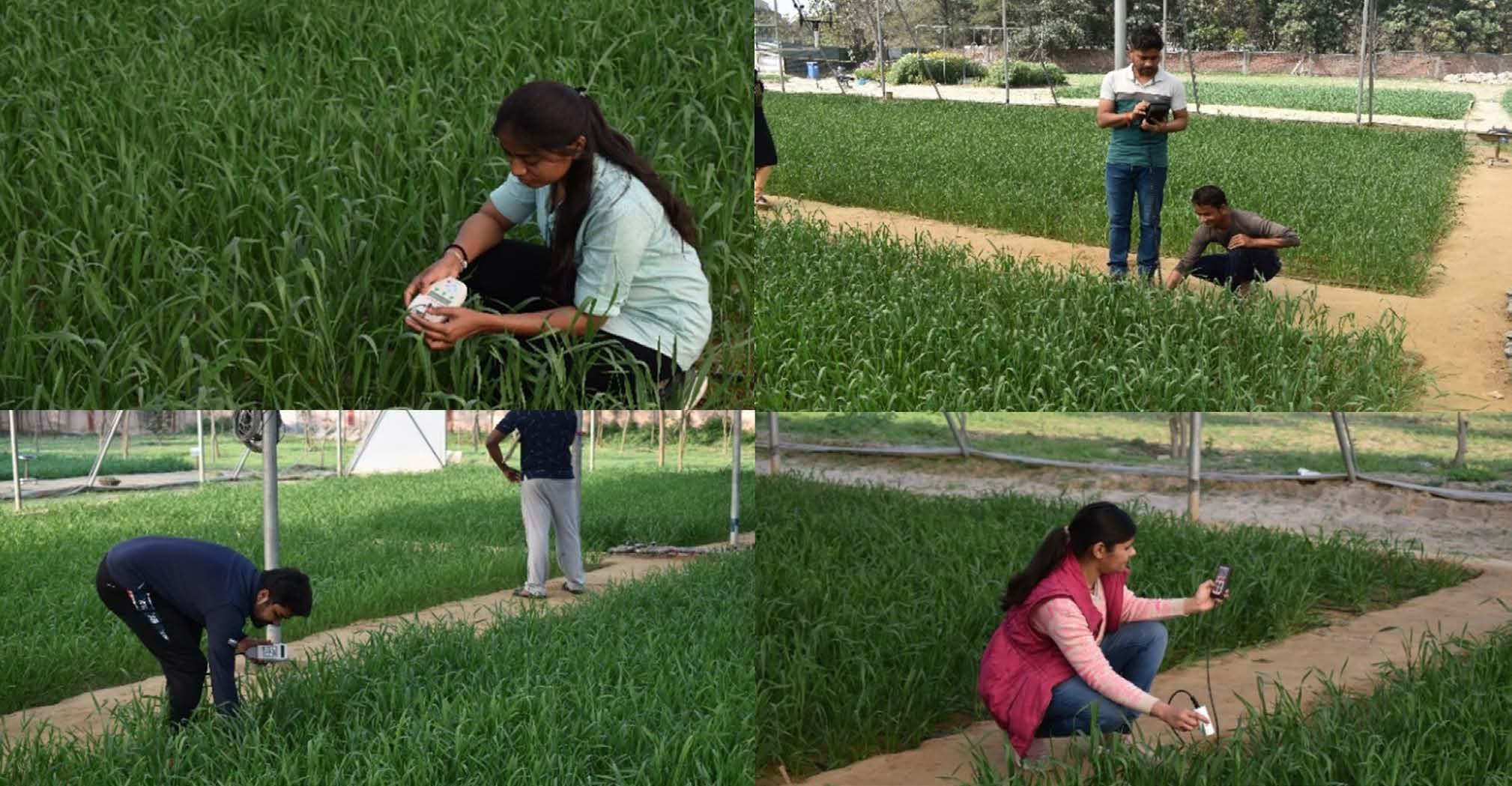

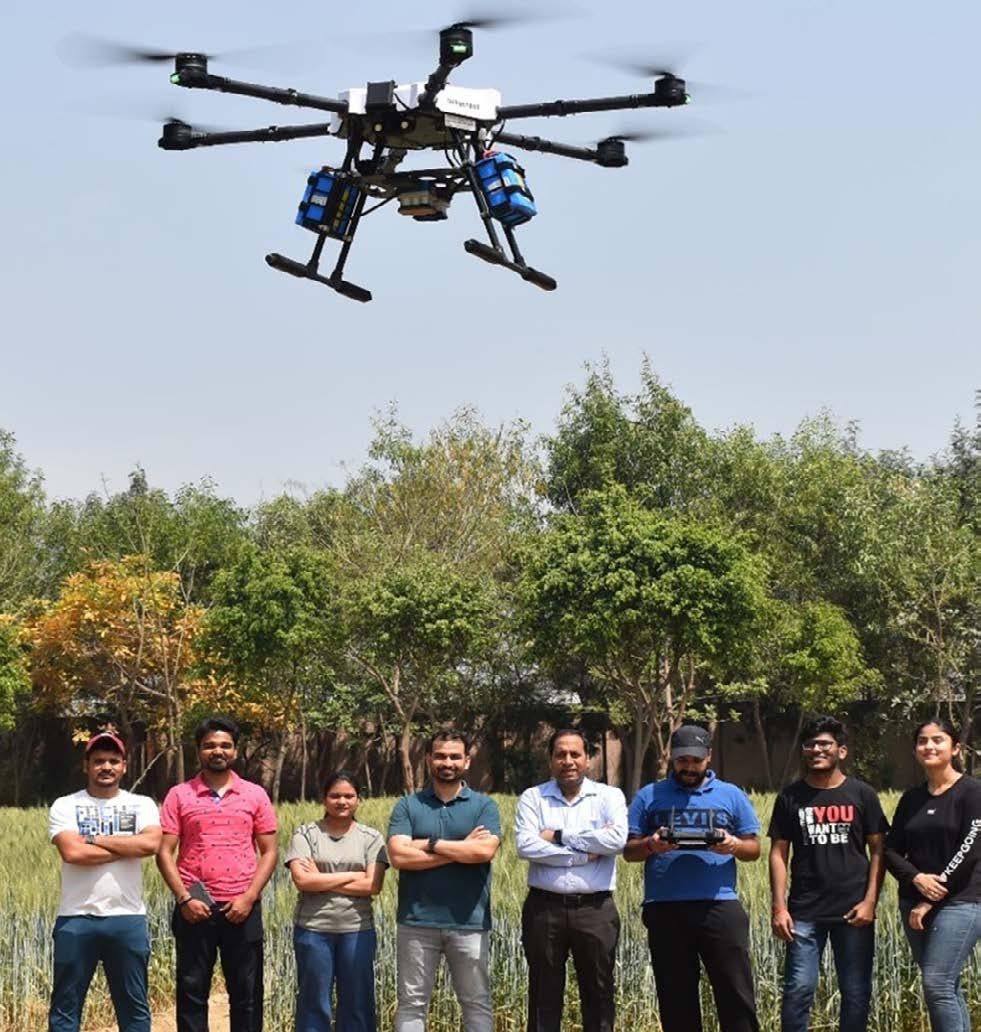
Water Resources Engineering Computational Lab
The Computational Lab stands at the forefront of technological innovation, utilizing advanced computational tools to address pressing challenges in water management. From simulating river dynamics and groundwater flow to harnessing the power of geospatial analysis and precision agriculture mapping, this lab exemplifies the fusion of computational science and water-related research for a sustainable and water-resilient future.
Environmental Engineering Laboratory:
This lab is equipped to monitor water and wastewater qualities, with sensors for various parameters like total dissolved/suspended solids, turbidity, hardness, and more.
A group of graduates and doctoral students are working on some exciting projects.
Simultaneous removal of carbon, nitrogen, and phosphorus from landfill leachate using an aerobic granular reactor (AGR)
Landfill leachate majorly consists of carbon, nitrogen, phosphate, metals, and other micropollutants, which pose a severe threat to the environment. In this
project, an aerobic granular reactor (AGR) has been developed to treat landfill leachate collected from a landfill site. The AGR successfully removed carbon, nitrogen, and phosphorus simultaneously at higher organic loading. The co-treatment of leachate and wastewater is investigated using AGR to determine its stability.
Treatment of domestic sewage and leachate using a moving bed hybrid bioreactor (MBHBR)
The treatment of domestic sewage using a moving bed hybrid bioreactor (MBHBR) has been investigated by varying the concentrations of chemical oxygen demand (COD), ammonia, phosphorus, and hydraulic retention times (HRTs). The metagenomics study has been performed to identify the predominant microorganism in MBHBR, which played a significant role in the treatments of sewage and leachate. The MBHBR has shown higher removal efficiencies for COD, ammonia, and phosphorus during the co-treatment of sewage and leachate.
Conversations on Campus
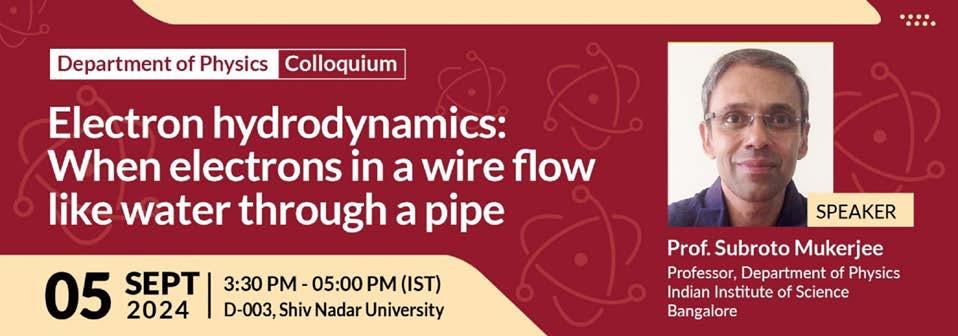
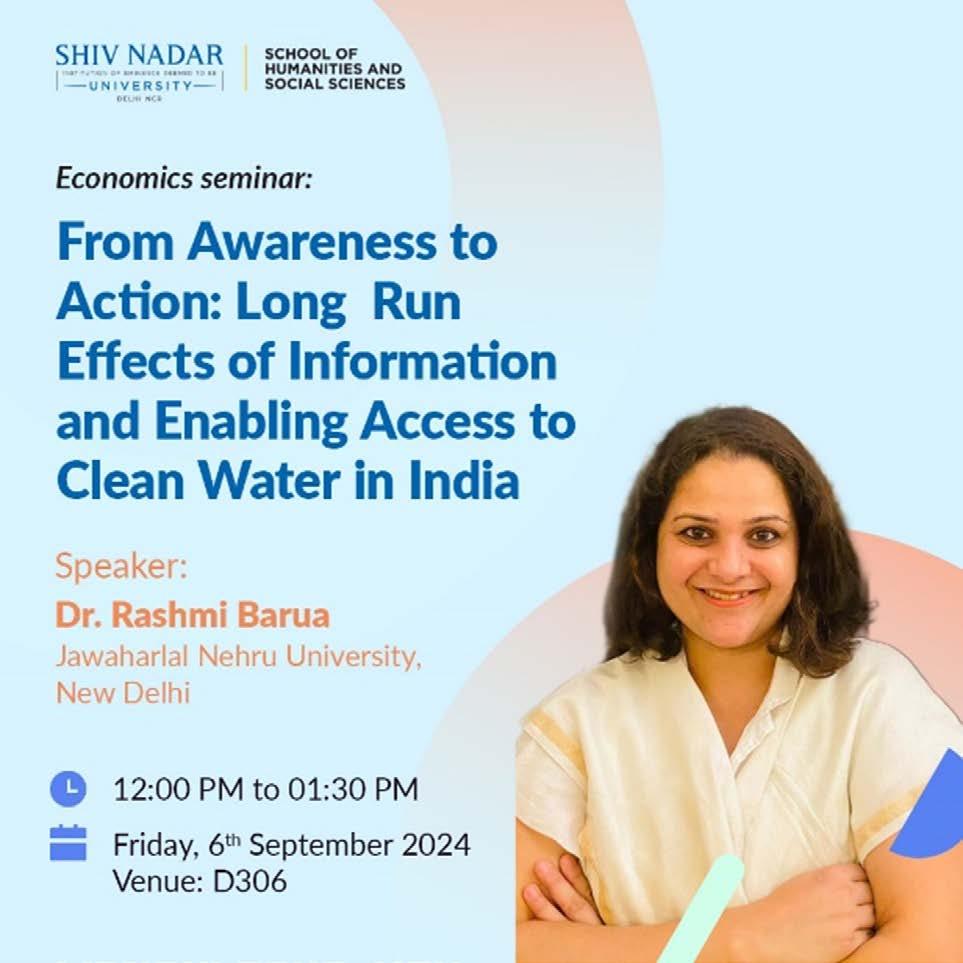

INSTITUTIONAL PRACTICES
Reinforcing daily our commitment to water
Shiv Nadar University has a Water Management and Re-Use Policy that reflects the intent and commitment of the leadership of Shiv Nadar University towards the conservation of natural resources and promoting knowledge and awareness amongst all its interested parties.
Following are some highlights:
• Extensive process for on-campus water use and re-use system ensures compliance with the daily extraction limit provided by the Central Ground Water Authority (CGWA).
• Rainwater harvesting system installed in buildings on campus; drainage system collects, filters, and releases stormwater into an artificial and natural lake.
• Water reuse for horticulture through tanks and pipes for irrigation; reused water is measured by recording the number of tanks sent for horticulture purposes and the amount of water sent through pipes.
• The campus land is equipped with 40 KLD of solar water heating system
• The sewage treatment plant of 884 KLD capacity is installed with the latest technology, and sewage water is treated through membrane bioreactor (MBR) technology. A part of the treated water is directly supplied for domestic use in washrooms and cleaning activities. A portion of the treated water is provided to be further filtered and passed through a UV reactor before being stored in the treated water and used for drinking. Chemical testing and analysis ensure that all relevant parameters are within acceptable limits.
• Water consumption is regularly monitored and analyzed for carbon footprint computation and usage trends to identify opportunities for further improvement. Signages are placed across the campus promoting conscious water usage.
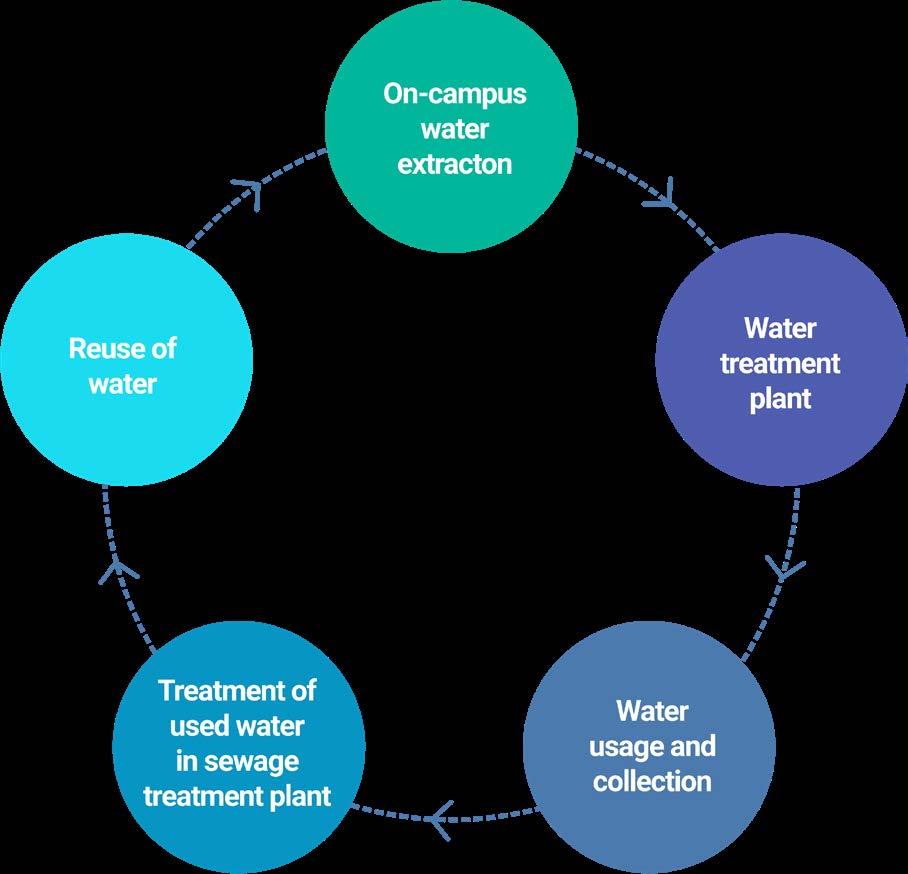
Prevention of pollution of water systems
University infrastructure is designed and deployed to avoid contamination, wastage, and loss of water in transit and enhance reuse. This is achieved by tracking water use and reuse through maintaining logs and conducting analysis to identify opportunities and undertake initiatives for continual improvement.
Processes and controls are deployed to prevent water leakage from the pipelines and maintain the quality and safety of water.
• All water pipes are placed in separate concrete trenches, not allowing infiltration of water from any other source
• Water pipelines are sealed and reviewed at periodic intervals to identify any possible leakage
• Pressure differential gauges are installed to detect any possible leakage.
• Littering on campus is strictly prohibited and monitored near the lake through guards and CCTV surveillance. In addition, signage is placed on campus to prevent contamination of ground or water systems.
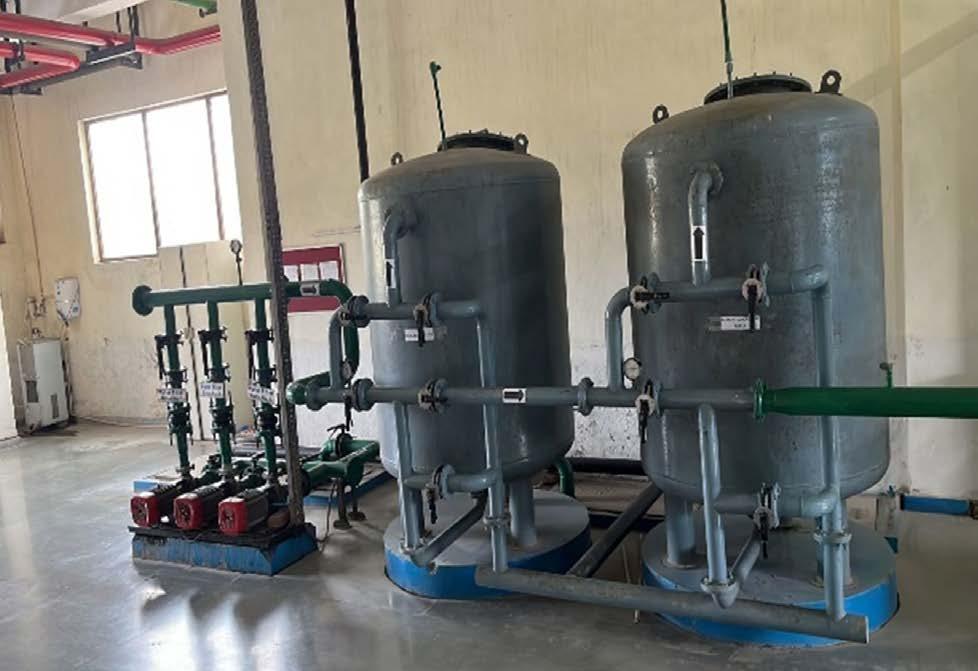


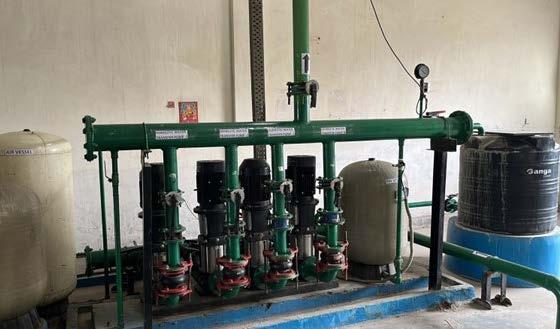
University Infrastructure – Water efficiency in renovations, building designs, and upgradation
At Shiv Nadar, all buildings, including the 120,000 square ft. sports complex, are certified by the Leadership in Energy and Environmental Design (LEED). The LEED Gold-certified buildings have state-of-the-art water harvesting and waterefficient plumbing fixtures and in-built efficient water conservation systems, including water meters, efficient taps, and waterless urinals. The buildings are also IGBC (Indian Green Building Council) certified since they satisfy the extensive requirements for water conservation and rainwater harvesting (roof or non-roof) and water-efficient plumbing fixtures. The university meets both these requirements, including 15% of the credits that impact water resources.
Commitment to maintaining rich biodiversity on campus
We are committed to maintaining the rich biodiversity on campus, including the campus lake. The lake’s revival has allowed many fish and aquatic plants to thrive. It is home to many species of birds that are endangered, near threatened, or vulnerable in the International Union for Conservation of Nature (IUCN) category. All efforts are being taken to preserve the lake and its natural ecosystem. During summers, the lake is supported by external water to maintain life underwater, and the water is conserved and rejuvenated through rainwater harvesting.
Signages near the natural and artificial lakes restrict any act that might contaminate the water bodies. The deployed security team also maintains strict vigil to ensure no one pollutes the water bodies by throwing any garbage, entering the water body, or disposing of any chemicals in these lakes.
Water-conscious planting has resulted in a green campus and reduced irrigation requirements. The campus has many drought-tolerant plants, such as Acacia auriculiformis A.Cunn.ex Benth., Albizia lebbeck (L.) Benth., Casuarina equisetifolia L.

Sessions with local support staff
The University regularly holds sessions with its local support staff to upgrade knowledge and technology to efficiently use resources at home, at the workplace, and in the community. These include workers on campus and farmers from local villages and towns who work on campus. Sessions are held in the local Hindi language and include themes like water efficiency, sustainable water management, irrigation, energy efficiency, agricultural practices, etc.
All campus janitors, workers, and vendors have access to free filtered water for cooking. The University supplies free drinking water through tankers to a community of workers near the university.
A piece with a brief on some of those who nurture the water and biodiversity of the lush green campus of Shiv Nadar University
Some of these gardeners and caretakers have been with the University since its founding. The University has created many opportunities for locals in the vicinity who not only nurture the soil but also understand the local needs for biodiversity and water. The experience of walking through the lush green university campus and the 10.4 acres of botanical garden is enhanced manifold by the trained local gardeners who fill us in with all the local information and significance of each plant. For many of our visitors, our gardeners’ knowledge of the garden is a treat, and we refer to them as the wind beneath the wings of the garden.
Those who nurture the water and plants
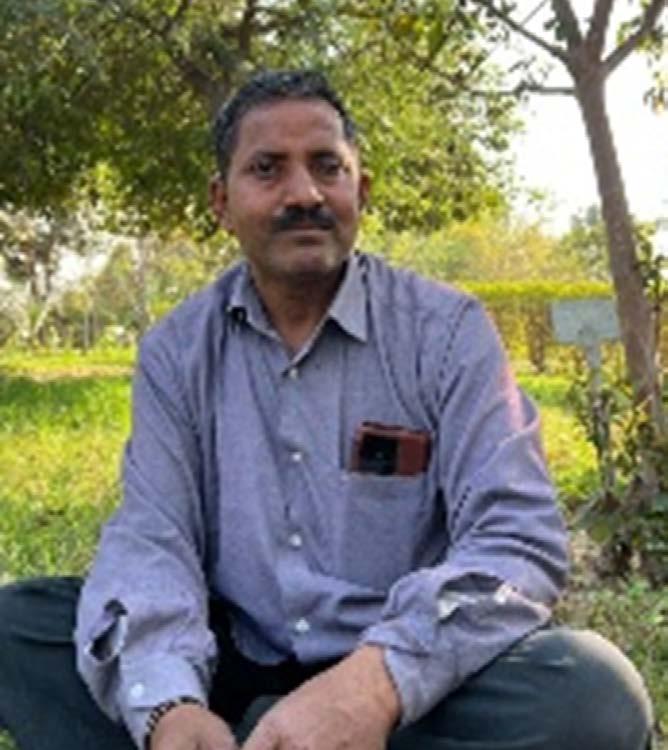


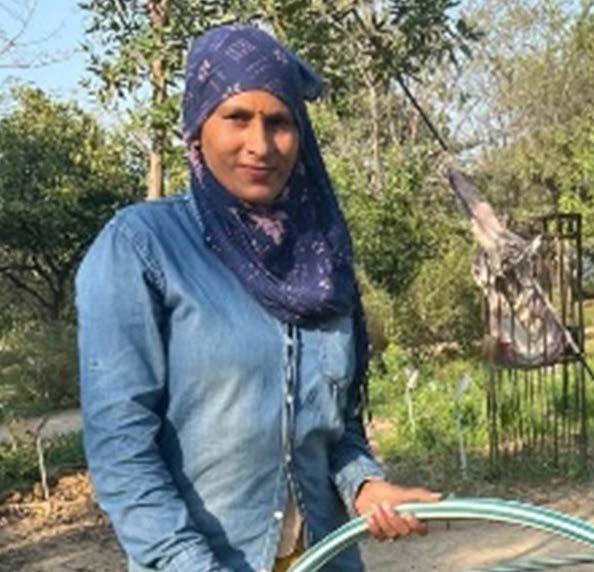
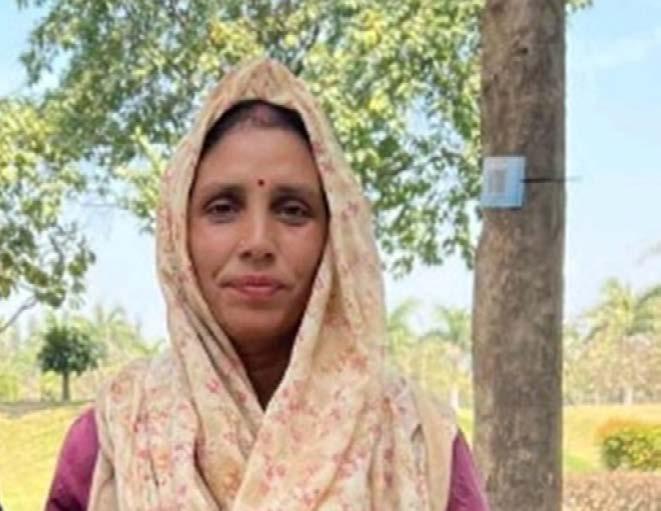
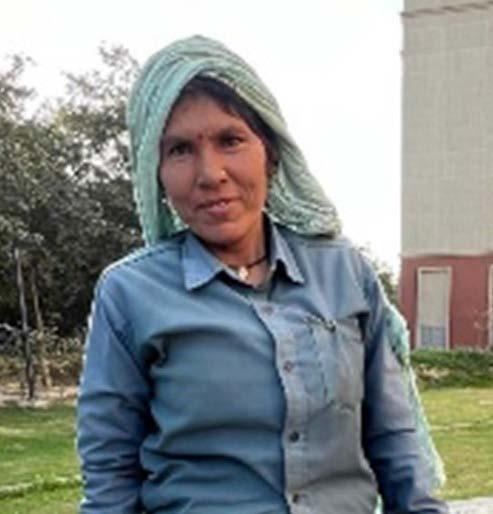
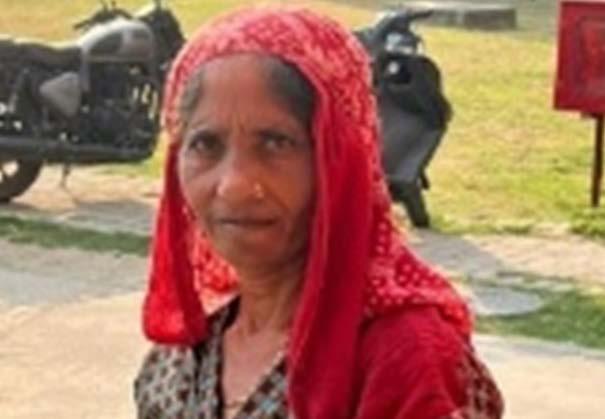

PARTNERSHIPS
Department of Science and Technology, Government of India, supports start-up research projects.
Dr. Gopal Das Singhal, Professor, Dr. Hitesh Upreti, Assistant Professor, and Dr. Ellora Padhi from IIT Roorkee received funding from the Department of Science and Technology to improve S&T Infrastructure (FIST). The grant runs until 2027 and includes sanctioned equipment like recirculating tilting flume and hyperspectral camera.
Background: In the present scenario, the usage of freshwater resources has increased, and the availability of the same has become erratic due to climate change driven by increased global temperatures and erratic rainfall behavior. In the Indian context, the situation is significantly more alarming since our country is home to around 18% of the world’s population but only possesses about 4% of the total global freshwater reserves (World Bank, 2019). Therefore, there is an urgent need to plan and manage the available water resources in a scientific manner. This is particularly important in agriculture and irrigation planning as the contribution of agriculture to the abstraction of freshwater is more than 80% in our country. The primary reason behind this is the poor water use efficiency in Indian agriculture. For this reason, the Government of India has started initiated missions such as “more crop per drop” (increasing water use efficiency), “har khet ko pani” (increasing the cultivated area under irrigation), and Goal 4 (Improving water use efficiency by 20%) of the National Water Mission.
The project aims to provide solutions for developing water-efficient irrigation strategies and mapping crop water stress that are vital for ensuring sustainable food production and water availability. Also, cascading instream storage strategies will be developed to promote self-sustained water and to mitigate flood scenarios. The project focuses on Sustainable Development Goals 2 and 6.
2. Indo-Japan collaborative research projectDevelopment of a cost-effective alternative to drone-based hyperspectral remote sensing for agricultural monitoring and yield estimation using machine learning techniques
Dr. Gopal Das Singhal, Professor, and Dr. Hitesh Upreti, Assistant Professor, Department of Civil Engineering, collaborate with Dr. Masaomi
Kimura and Dr. Yutaka Matsuno, Department of Environmental Management, Faculty of Agriculture, Kindai University, Japan.
The team is working on using drone-based remote sensing data and machine learning for agricultural monitoring and water management.
Dr. Masaomi Kimura at the Water Management Field Laboratory, Shiv Nadar University in March 2024
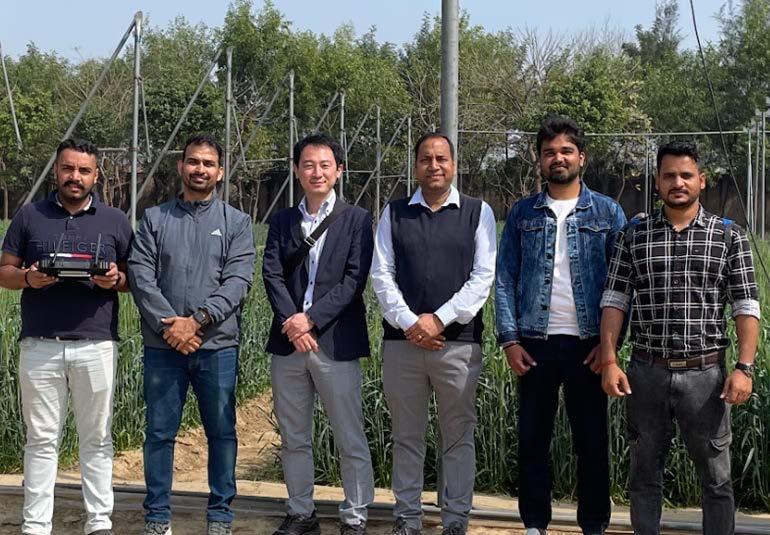
University in March 2024
3. Visible light induced removal of 1, 4-dioxane contaminant from drinking water using microfluidic technology: A cost and energy efficient strategy of water treatment
Dr. V. M. Rajesh, Ph.D., Assistant Professor, Department of Chemical Engineering, has collaborated with Dr. Subhabrata Sen, Professor, Department of Chemistry, on a project funded by Shiv Nadar University. The research aims to create an economically and energetically efficient method for eliminating the 1,4-dioxane contaminant from drinking water, utilizing visible light-induced microfluidic technology for water treatment. The project is funded under the FGIR (Faculty Grant for Interdisciplinary Research) grant until July 2025.
4. Building a larger community of social transformers is essential to the vision that animates the field component in the master’s program in Rural Management
The master’s program on Rural Management at Shiv Nadar University is based on a unique pedagogy that provides students with an indepth, multi-disciplinary understanding of the problems of rural India, combining innovative classroom and studio teaching with two full

semesters devoted to field education, including internships with the best practitioners in rural India, nurturing their capacity to find innovative and far-reaching solutions.
Students intern with organizations that have done pioneering work over several decades in some of the most difficult management challenges facing rural India in areas of participatory water management, sustainable agriculture, rural livelihoods, women’s empowerment, drinking water, sanitation, and innovation, to name a few.
The semester is an excellent opportunity for students to learn and receive training amidst the local communities and cultures guided by our partners, Gram Vikas1, Samaj Pragati Sahayog (SPS)2 Advanced Center for Water Resources Development and Management (ACWADAM)3, and the Center for Sustainable Agriculture4
5. Development of AI-based DSS for improved crop water use efficiency under regulated deficit drip irrigation regime in the backdrop of climate change (2020-2023)
India has reached a Critical Water Stress level of 1400 cum/person/annum and rushing to an Extremely Critical ‘Water Scarce’ threshold limit of 1000 cum/ person/annum in the not-too-distant future. This rise in water demand is ascribed to population growth and multi-sectoral water uses and is compounded by global warming and climate change.
Dr. Gopal Das Singhal, Professor, and Dr. Hitesh Upreti, Assistant Professor, Department of Civil Engineering, received a grant of INR 105 lakhs from the Department of Science and Technology to work on this three-year project.
Recently completed, this research project used drip irrigation combined with regulated deficit irrigation (RDI) to improve the water use efficiency in agriculture. Controlled crop experiments were conducted for multiple crop seasons in which wheat was grown under varying water application treatments to study the effect of water stress on crop growth and crop yield. In addition to the field data (soil and crop parameters) collected using different equipment, remote sensing data was acquired using infrared radiometers and spectroradiometer. During the experimentation, a drone-based multispectral camera was employed to observe the spatial variation in crop growth.
A thorough assessment of crop water stress at different crop stages on wheat yield was conducted, and recently, a Ph.D. scholar graduated working in this area.
Yadav A., Muni, L., Upreti, H., Singhal, G.D. (2024). Quantification of crop water stress index of wheat by using machine learning models. Environmental Monitoring and Assessment, 196, 970.
1An NGO based in Odisha works to enable rural communities to lead dignified lives. This is done by building the capabilities of village communities, strengthening community institutions, and mobilizing resources.
2One of India’s largest grass-roots initiatives working towards women’s empowerment, water, and livelihood security.
3A not-for-profit organization that aims to establish a groundwater management agenda in India with a mission to demystify groundwater science and strengthen the hydrogeological capacity of institutions working in the water sector in India.
4An organization that works with a vision to become a national institution to lead the transition of Indian agriculture to become ecologically and economically sustainable
Shiv Nadar Institution of Eminence is fully committed to the UN Sustainable Development Goals (SDGs). We have embraced a four-pronged strategy for SDGs through teaching, research, our core institutional practices, and partnerships.
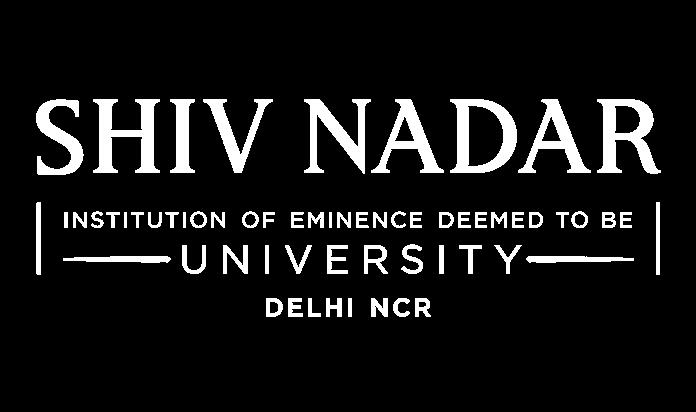
Deepa Hazrati Senior Manager, Office of the Vice-Chancellor deepa.hazrati@snu.edu.in
